ARM A53/A57/T760 investigated - Samsung Galaxy Note 4 Exynos Review
by Andrei Frumusanu & Ryan Smith on February 10, 2015 7:30 AM ESTGPU Performance
In the graphics department we're matching up Qualcomm's Adreno 420 versus the Mali T760MP6. The Adreno is running at 600MHz and is able to benefit from almost double the memory bandwidth at 25.6GB/s versus 13.2GB/s due to the Snapdragon's increased 128-bit memory interface. Let's look at how both compare in our overall benchmarks:

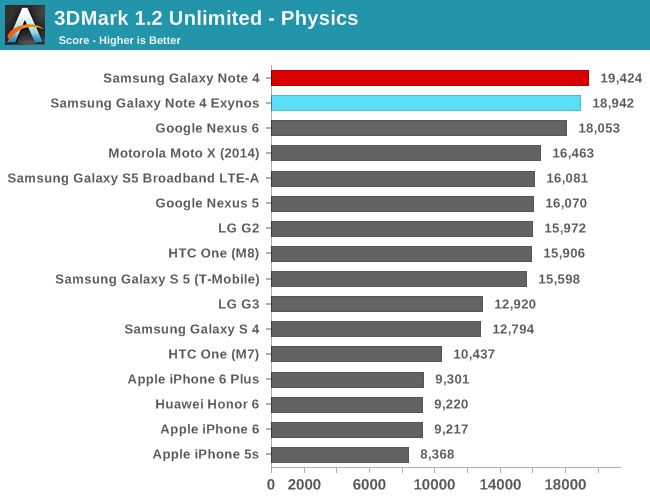
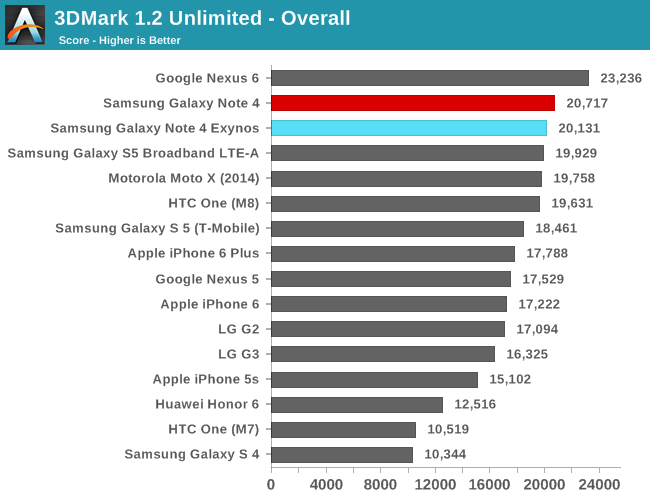
In 3DMark Unlimited the Exynos version comes just short of a few fps behind the Adreno 420. What is also surprising is that the Exynos 5433 performs much better in the physics score than I had anticipated; the same test on Huawei's SoCs limited the thread onto the little cores in the default settings giving mediocre performance results. However, it seems the A53 is performing much better and is able to match Qualcomm's offering now.
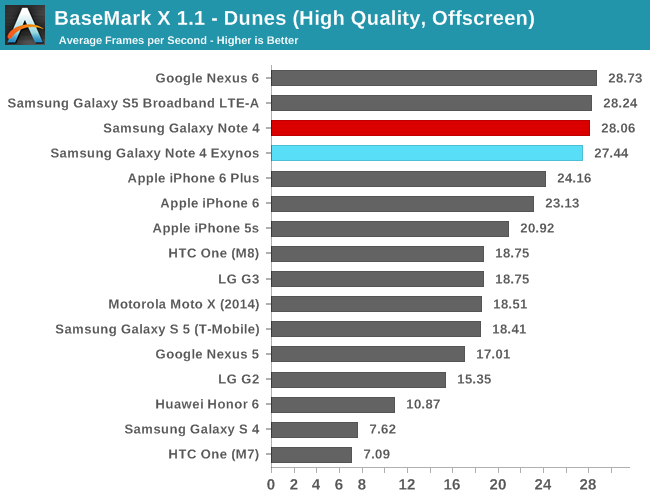
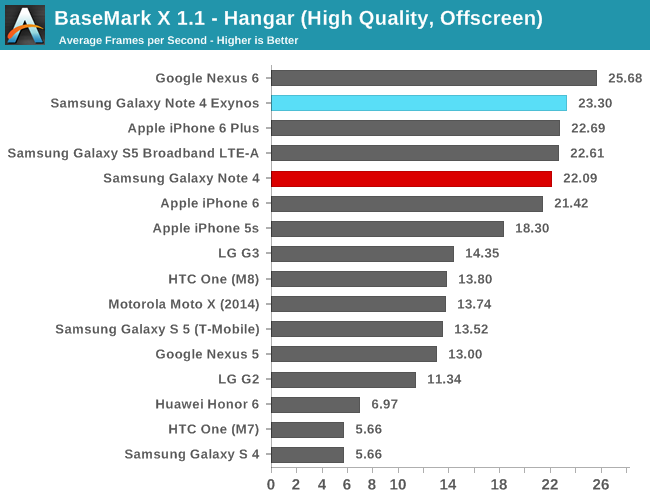
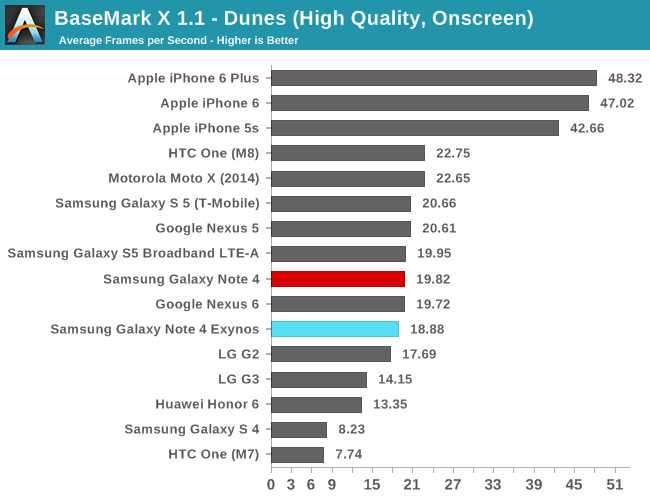

In BaseMark X 1.1, the Exynos is again neck-and-neck with the Snapdragon version. It loses by a slight margin in the Dunes benchmark while winning in the Hangar scenes by a similarly small margin. BaseMark X is again one of the benchmarks that can trigger the 700MHz state of the Mali GPU, offering higher performance at a much higher power draw depending on which scene is currently rendered on both tests.
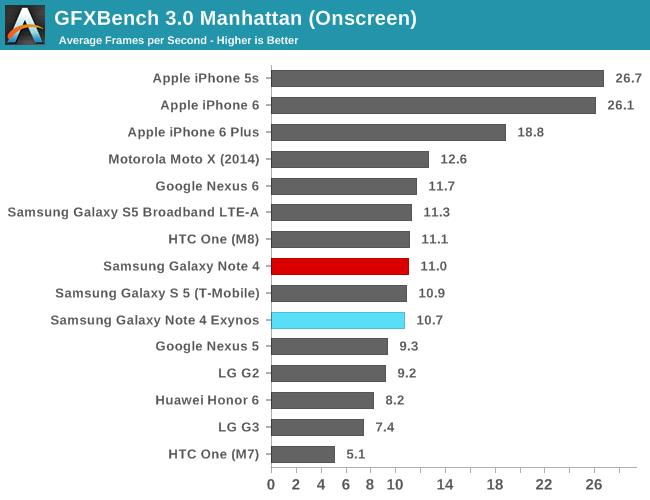
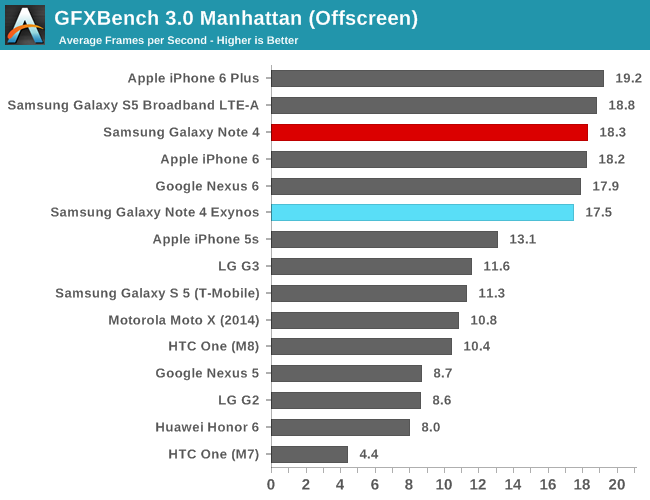
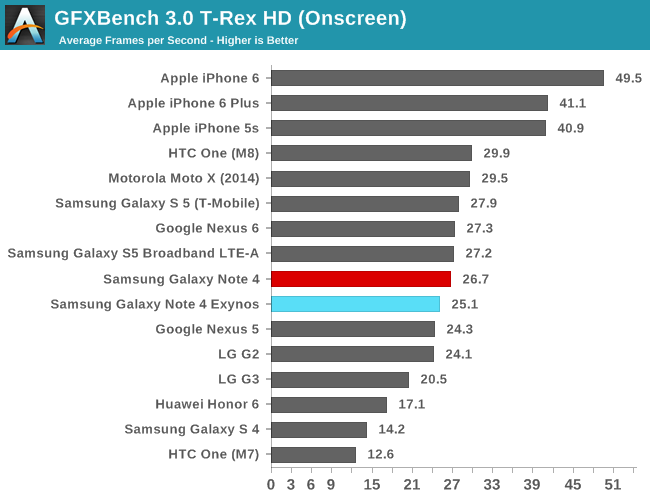
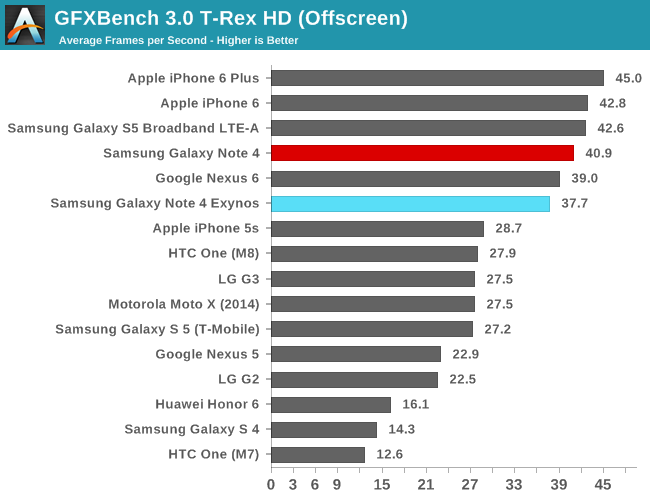
Again we continue to see the same pattern in GFXBench's scenario benchmarks, with the Exynos version lagging a few frames behind the Qualcomm GPU in both Manhattan and T-Rex, in both on-screen and off-screen results.
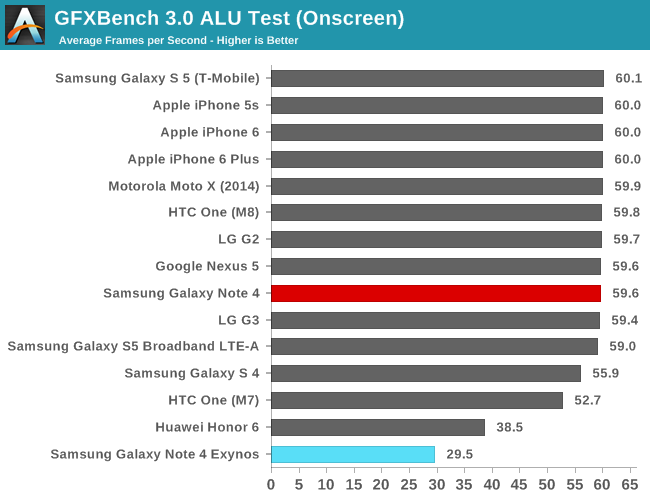

It's on the synthetic tests that we finally see some major deviation between the two architectures. ARM's Mali simply can't seem to keep up with the ALU throughput of Qualcomm's architecture. Both the Adreno 330 and 420 have a clear computational power advantage, exceeding even Imagination's PowerVR GPUs in the iPhones, leaving Mali strictly on the lower end of the performance spectrum.
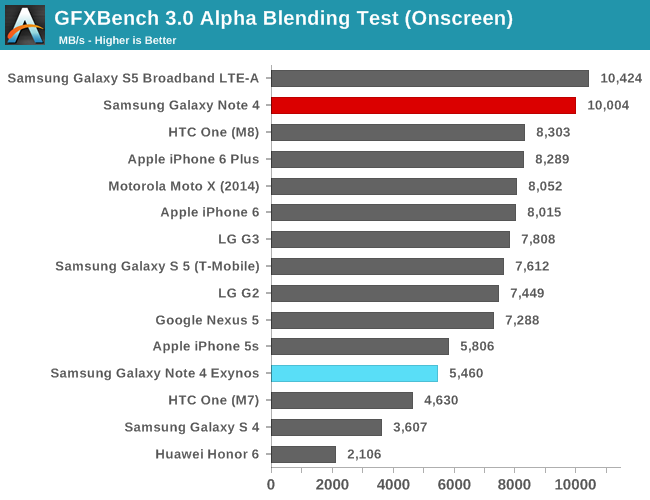
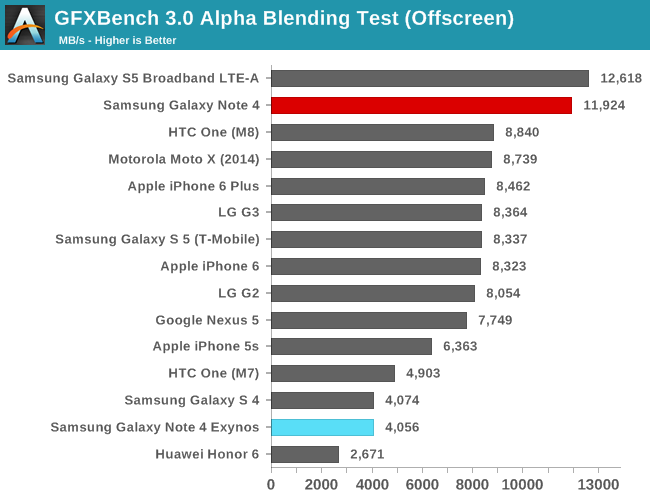
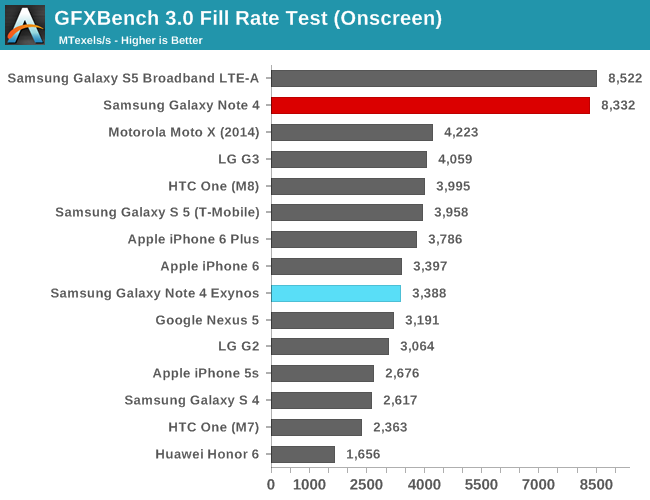
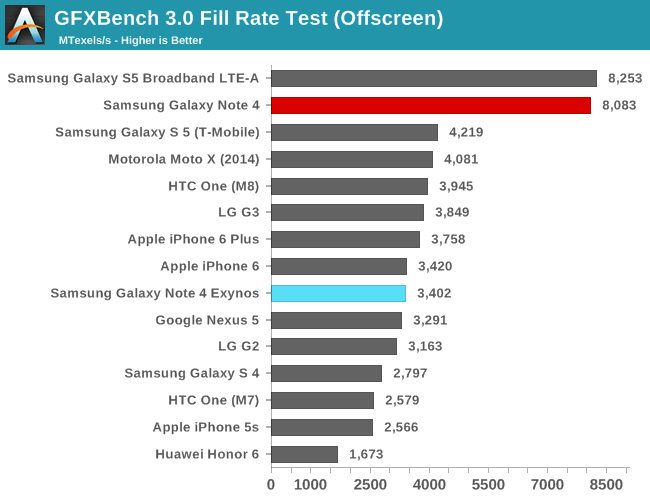
We see a similar situation in the Alpha Blending and Fillrate tests, as the Adreno offers 2-3x the throughput. Utilizing the extra memory bandwidth here seems to be key to the success of the Snapdragon 805's graphics performance.

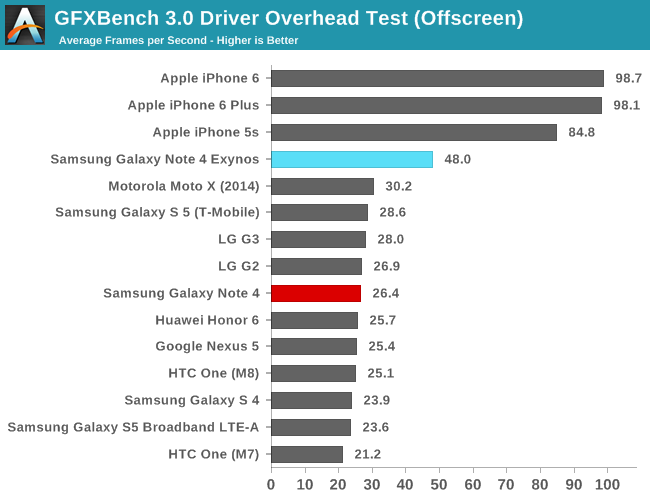
I've already mentioned the Driver Overhead score in the the more in-depth analysis of the T760. It's the first Android device to truly stand out from the rest of the crowd, finally making some progress into trying to catch up with Apple's excellent performance on iOS. Here's hoping more vendors concentrate on improving this metric in future driver updates.
I did some extensive power measurements on the Note 4 Exynos in this review, so naturally we're keen to see how this transforms into our battery benchmarks on the next page.










135 Comments
View All Comments
MrSpadge - Tuesday, February 10, 2015 - link
Excellent work, guys! But let me point out something:1. Your Geekbench numbers show spectacular gains for the A53. They're actually so good that the multi-threading speed-up almost always exceeds the number of cores (judging by eye, have not run the numbers). For A7 the speedup factor is a bit less than 4, right where it should be. It certainly looks like the big cores were kicking in, at least partly.
2. You wonder that power scales sub-linearly with more cores being used. Actually this is just what one would expect in the case of non-ideal multi-thread scaling (as the A7 shows in Geekbench). The load of all ccores may be the same, percentage-wise, but when running many threads these are competing for L2 cache and memory bandwidth. There will be additional wait times under full load (otherwise the memory subsystem is vastly oversized), so each core is busy but working a little less hard.
3. The lower performance per W of the A53: this may well be true. But if the big cores did interfere, it could certainly explain the significantly increased power draw.
4. You hope for A53 at 1.5 - 1.7 GHz. I agree for CPUs which use only A53's. But as little cores this is not necessary. If you push a design to higher frequencies at the same technology node you always pay in terms of power efficiency (unless you start bad / unoptimized). Better let the little cores do what they're best at: be efficient.
... I'm off to the next page :)
MrS
Andrei Frumusanu - Tuesday, February 10, 2015 - link
Regarding your concerns on the big cores turning on: They did not. I made sure that they're always offline in the little testing. As to why GeekBench scaled like that, I can't answer.jjj - Tuesday, February 10, 2015 - link
Geekbanch scales like that sometimes, TR looked at this phone last week and they notice the Shield tab scaling better than 4x in some tests.For the A53 better scaling over A7 maybe it's the memory subsystem? No clue how heavy GB is on it but the A53 does have more memory BW and maybe faster NAND (you don't have storage tests for the Alpha ).
MrSpadge - Tuesday, February 10, 2015 - link
Sometimes one gets such results if the MT code path uses newer libraries to get multi threading, but also introduce other optimizations the tester is not aware of. Or they have to rewrite code/algorithm to make it multi-threaded and thereby create a more efficient version "by accident". I don't know if any of this applies to GB, though.tipoo - Tuesday, February 10, 2015 - link
It's done that before, I think the cache is almost certainly involved. Maybe it has good cache reusability for multicore in its testing.SydneyBlue120d - Tuesday, February 10, 2015 - link
Excellent article, thanks a lot for that.I'd like to dig deeper about why Samsung is ruining the wonderful Wolfson DAC, I remember that even the legendary François Simond shared the issue with Samsung Developers without getting a response, maybe You will be able to have a response :) Also, I remember an audio quality test suite, why didn't You use it in this review? Thanks a lot.
Andrei Frumusanu - Tuesday, February 10, 2015 - link
We realized testing audio without having the proper equipment is a futile exercise and does not really portray audio quality of a device. Only Chris has the professional equipment to objectively test audio, such as done in the iPhone6 review: http://www.anandtech.com/show/8554/the-iphone-6-re...PC Perv - Tuesday, February 10, 2015 - link
Thank you so much for ditching SunSpider, and thank you for explaining why. It has gone way too long.PC Perv - Tuesday, February 10, 2015 - link
I know you are trying to be nice to your colleague and give them a benefit of doubt, but to mercilessly critical eyes of mine your colleagues (Joshua Ho & Brandon Chester) have shown and time and time again they are not qualified to review Android products. I hope Mr. Frumusanu and Mr. Smith will take charge of this area in the future and limit those two to Apple product reviews.I would love to read quality reviews and analysis like this instead of their tamper tantrum.
PC Perv - Tuesday, February 10, 2015 - link
For example, in the comment section here,http://www.anandtech.com/comments/8795/understandi...
[Q]The increase in brightness for AMOLEDs at 80% APL rather than 100% APL is not very significant, and changing testing to accommodate AMOLED's idiosyncrasies doesn't seem like a good idea either. To put it in perspective, even if I had tested the Nexus 6 at 80% APL in the review my conclusion about the brightness being sub-par would have been exactly the same.[/Q]
That is what Brandon Chest had to say about brightness of the Nexus 6's screen. So arrogant, so biased. But according to the scientific data provided by this article (pg. 10), APL can indeed make a huge difference in AMOLED screen's brightness, given power target. For example, at display power target is 1W, 70% APL will raise the brightness by approximately 40%. At 50% APL, max brightness practically doubles.
I was appalled by the disparaging and arrogant attitude by Brandon Chester when it comes to correctly evaluating Android devices. He also made similarly nonsensical "arguments" in his tablet recommendation article for the holidays.